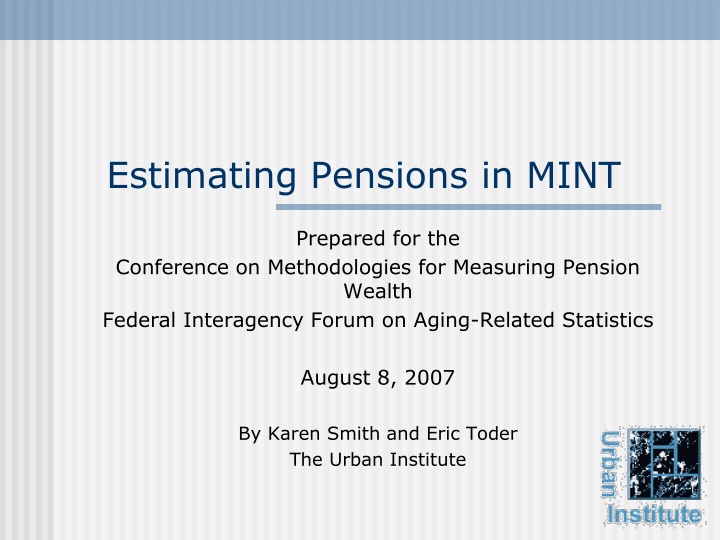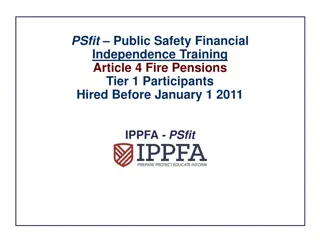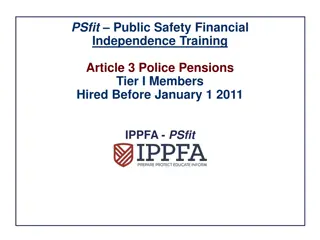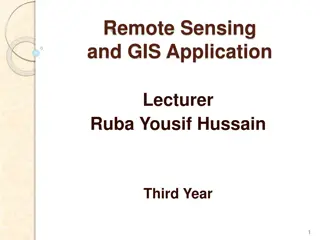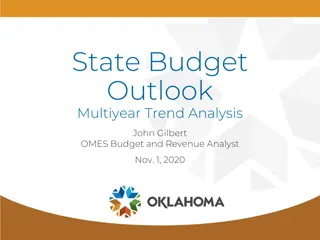Estimating Pensions in MINT: Data Sources and Projections
This document discusses the Model of Income in the Near Term (MINT) microsimulation data system, detailing its projections on income, assets, taxes, and demographic characteristics for birth cohorts up to 2099. It explores data sources such as the Survey of Income and Program Participation (SIPP), Social Security Administration data, and Pension Benefit Guaranty Corporation data, among others, used in estimating pensions.
Download Presentation

Please find below an Image/Link to download the presentation.
The content on the website is provided AS IS for your information and personal use only. It may not be sold, licensed, or shared on other websites without obtaining consent from the author.If you encounter any issues during the download, it is possible that the publisher has removed the file from their server.
You are allowed to download the files provided on this website for personal or commercial use, subject to the condition that they are used lawfully. All files are the property of their respective owners.
The content on the website is provided AS IS for your information and personal use only. It may not be sold, licensed, or shared on other websites without obtaining consent from the author.
E N D
Presentation Transcript
Estimating Pensions in MINT Prepared for the Conference on Methodologies for Measuring Pension Wealth Federal Interagency Forum on Aging-Related Statistics August 8, 2007 By Karen Smith and Eric Toder The Urban Institute
Model of Income in the Near Term (MINT) Microsimulation data system projects income, assets, federal and state income taxes, and demographic characteristics of the 1926 to 1972 birth cohorts to 2020. The MINT5 extension augments the MINT4 projections to include the 1926 to 2018 birth cohorts to 2099. MINT5 provides a fairly comprehensive set of characteristics for evaluating the income sources and measures of well-being for recent and future retirees.
Data Sources (SIPP) MINT begins with the 1990 to 1996 SIPP panels matched to Social Security Administration longitudinal data SIPP data includes Demographic characteristics (age, sex, race, Hispanicity, birth place, State) Marriage and fertility history Pension data Housing and financial assets SIPP has characteristics of individual recipients, but is not matched to employer data on pension plans
Data Sources (SSA data) Social Security Administration data includes SER (Social Security covered earnings 1950- 2004). DER (IRS earnings, including employee deferred contributions and earnings above the Social Security taxable maximum 1982-2004). MBR (Social Security benefit history file through 2004). SSR (SSI benefit history file through 2004). Numident (Social Security mortality file through 2004).
Data Sources (pension data) Pension Benefit Guaranty Corporation s (PBGC) Pension Insurance Modeling System (PIMS). Form 5500 data 1990-2003 (information on cash balance plans). EBRI/ICI database for assumptions regarding employer DC contributions and asset allocation behavior. Policy Simulation Group s PENSIM to project job changes.
Data Sources (tax data) 2003 Statistics of Income data statistically matched to the 1996 SIPP panel Match on taxable earnings, DB pension income, Social Security benefit, money asset income, calculated tax filing status, home ownership, state. SOI provides itemized deductions, non- projected income sources (alimony, capital gains, etc.).
Projections From this richly detailed starting file, including actual historic earnings, education, fertility, family composition, wealth and pension characteristics, MINT projects for sample individuals: Marriage, remarriage, and divorce. Mortality and widowhood Immigration and emigration Fertility Disability Earnings and job changes Housing and financial asset accumulation and spend down Pension wealth (DB, DC, CB) Retirement and benefit take-up Social Security benefits, SSI Federal and State income taxes Co-resident income MINT projections are calibrated to hit OCACT targets for earnings growth, disability, mortality, and immigration.
Types of analysis Characteristics of recent and future retirees. Distribution of retirement income sources for recent and future retirees. Sources and amounts of income by characteristic. Distributional impact of Social Security reform options. Distributional impact of changes in pension characteristics. Distributional impact of tax changes on income and retirement assets.
Steps in Pension Projection 1) We obtain self-reported information on pension coverage for past and current jobs from the SIPP. 2) We use data from the PENSIM model to impute job changes and pension coverage on future jobs. 3) We calculate pension benefits from past, current, and future jobs. a) PBGC data for DB plans b) EBRI/ICI assumptions to grow wealth in DC Plans
Job Changes Policy Simulation Group s PENSIM model was developed for the Department of Labor. Simulates job histories using job tenure models estimated from the SIPP and applied to a synthetic dataset of workers. PENSIM simulates pension coverage using estimates from the National Compensation Survey, CPS, and Form 5500 data. For each job, a worker can have No pension, DB pension, DC pension, or both DB and DC.
Model Job Changes MINT links workers to PENSIM job histories by gender, education, employment history, job tenure, age, industry, firm size, pension coverage (at SIPP interview). Find the best PENSIM match. PENSIM imputes pension coverage on future jobs. Assumes no changes in pension job after age 50.
Workers with DB Pensions We assign a DB plan from the PIMS data for workers reporting having a DB plan. Assignment by firm size, industry, union status, and whether the worker also has a DC plan. The PIMS data includes plan specific parameters for determining pension benefits (plan type, early and normal retirement age, reduction factors, accrual rates, service thresholds). PIMS data gives us enough information to calculate pension income for workers at retirement, given job tenure and earnings.
DB Plan Dynamics To account for the shift from DB to CB, and DB plan freezes We add a time dimension to the PIMS data. We assume that worker behavior has not changed, but a worker in a firm that switched to a CB plan would convert to a CB plan in the year of the conversion. Similarly, a worker in a firm that froze its DB plan would convert to a substitute DC plan.
Cash Balance Plans Use Form 5500 data from 1990 to 2003 to find plans that converted from DB to CB. Collect summary plan information for converted plans that are in the PIMS sample (51 plans). Model relevant CB plan parameters (year of conversion, interest rate, age and tenure structure, adjustments for earnings above Social Security tax max, transition provisions).
DB Plan Freezes Identify 23 DB plans on the PIMS data that have announced they have or will freeze their DB plan. Collect information on plan Freeze date, type of freeze, replacement plan characteristics. Employer contributions and match rates before and after the conversion.
Typical MINT projection Person Job Birth Year 1990 1991 1992 1993 1994 1995 1996 1997 1998 1999 2000 2001 2002 2003 2004 2005 Pension Type 1 2 2 3 4 5 5 1 1 2 1 1 1 2 1930 1950 1950 1945 1960 1950 1950 DB DC CB retire DC DB DC DB DC Age 1 2 2 3 4 5 5 1 1 2 1 1 1 2 1930 1950 1950 1945 1960 1950 1950 60 40 61 41 62 42 63 43 64 44 65 45 66 46 67 47 68 48 69 70 71 72 73 74 75 49 54 39 50 55 40 51 56 41 52 57 42 53 58 43 54 59 44 55 60 45 45 30 40 46 31 41 47 32 42 48 33 43 49 34 44 50 35 45 51 36 46 52 37 47 53 38 48 49 50 51 52 53 54 55 Key Defined Benefit Cash Balance Defined Contribution No Pension
DC pensions SIPP reports DC, IRA, and Keogh balances as of the SIPP survey (wealth topical module) Allocate starting balance into stocks and bonds that varies by age. Stock and bond balances earn a varying annual rate of return less a 1% administration fee. real return deviation 6.5% .17 3.3% .02 standard stock bond Rebalance portfolio every 5 years. Assets accumulate until retirement.
Asset Allocation by Age Asset Allocation by Age 100% 24% 25% 29% 34% 80% 48% 60% Percent Bond Stocks 40% 76% 75% 71% 66% 53% 20% 0% 25-29 30-39 40-49 50-59 60-69 Age
DC Pension Participation given offer Two participation models based on last year s contribution status (yes,no) estimated from 1996 SIPP/DER. Corrections to Census imputed pension type to be consistent with DER contributions. Includes actual worker contributions for 1990 to 2004 from the DER.
Determinants of DC Participation Participation much higher if contributed previous year For prior year contributors, varies with Earnings (+) Whether 1styear on new job (-) For prior year non-contributors, varies with Earnings (+) Whether 1styear on new job (+) For both groups, no effect of age, after controlling for earnings
DC Contributions Among participants we estimate employer contributions using a random-effects Tobit model Tobit controls the censored contribution amounts due to statutory contribution limits. Individual-specific error term is the average error term (DER contribution amounts predicted contribution: 1990- 2004).
Determinants of Worker Contribution Level Earnings (+) Job tenure (+) Contributed before (+) Employer contributes to plan (+) No. of dependent children (-) Whether spouse works (-) Earnings of spouse if working (+) Demographic characteristics Blacks and Hispanics < Whites Married Couples > Singles
DB Pension Benefit Calculation Use pension benefit formula and model projected retirement age to calculate pension income (federal, military, state and local government, private, union). Update pension income by colas: Self-report for retirees reporting having a cola on the SIPP. Imputed for future jobs. Update federal and military pensions based on plan values. Different treatment for federal and military workers who started before and after 1986. Provide a 50% survivor annuity to surviving spouse for retirees that reporting having a joint and survivor option. Impute joint and survivor take-up based on logistic model estimated on the HRS. Model includes pension wealth, financial assets, earnings, race, education, marriage duration.
Model Three Pension Scenarios High: Current pension status with know pension freezes through 12/2006. Medium: All private sector pensions freeze over the next ten years. Low: All private sector pensions and 1/3 of State and Local Government pensions freeze over the next five years.
Pension Coverage: High Option Pension Coverage at Age 67 by Pension Type and Birth Year 66% 65% 70% 65% 64% 64% 63% 62% 62% 61% 60% Percent of 67-Year-Olds 50% DB DC CB Any 40% 30% 20% 10% 0% 1931- 1935 1936- 1940 1941- 1945 1946- 1950 1951- 1955 1956- 1960 1961- 1965 1966- 1970 1971- 1975 Birth Year
Valuing Pension Well-Being for DB and DC Need a way to compare well-being (income) for retirees with a DB and DC. DB pensions pay a stream of benefits from retirement until death. Income includes both yield (interest rate) and return of principal. DC pensions accumulate a lump sum of assets. For comparability, need to measure income from DC plans to include both yield and return of principal We measure DC income as the fair market annuity on 80% of DC wealth. Estimate life expectancy based on race, gender, education, and life earnings to compute fair annuity Apply 20% discount for risk of outliving assets To compute path of DC income over time, we decay DC assets using an estimated asset spend down model. Two effects of aging on income: Lower wealth reduces income Reduced life expectancy raises income.
Average Per-Capita Income at Age 67 by Birth Year and Income Source Average Per-Capita Income at Age 67 by Birth Year and Income Source Restricted to Individuals with Wealth Below 95th Percentile 1.0 Income/Average Wage 0.8 SSI Imputed Rent Earnings Social Security Benefits Asset Income DB Income 0.6 0.4 0.2 0.0 1931-1935 1936-1940 1941-1945 1946-1950 1951-1955 Birth Year 1956-1960 1961-1965 1966-1970 1971-1975
Compare Pension Simulations Coverage Note: Charts showing effects of alternative pension freeze scenarios on pension coverage and retirement income of different cohorts will be added.
